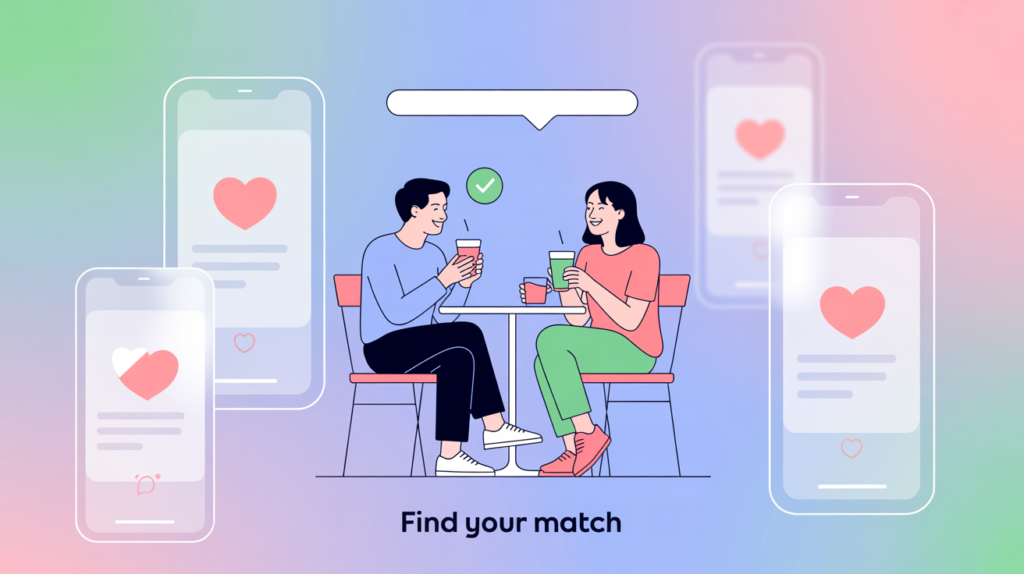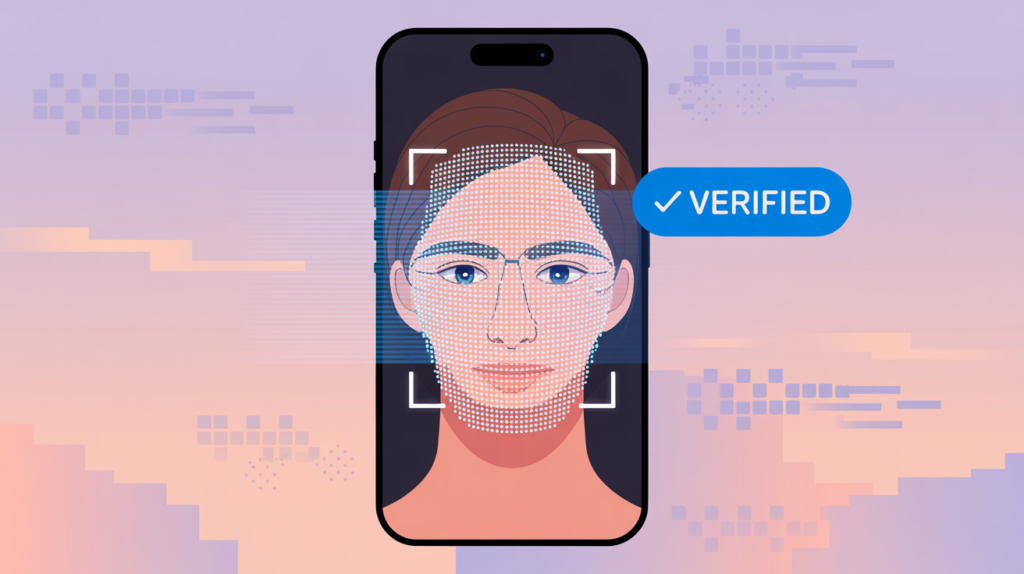Dating apps are plagued by fake profiles, bots, inappropriate content, and romance scams that cause people to lose trust in using them. In fact, safety concerns are a major reason many people avoid online dating.
According to a Bumble survey, 80% of Gen Z daters prefer to meet people with verified profiles—something that ultimately leads to more matches. Nearly 3 in 4 respondents said that security is a crucial factor in choosing a dating app.
Profile verification features have emerged as a key solution to rebuild trust and protect users. Verifying a profile with a facial recognition helps confirm the person is real and matches their photos. This stops imposters and scammers from deceiving others.
Verify your profile to go on more dates
Tinder reports that verified profiles lead to more matches. In one analysis, photo-verified users aged 18–25 saw approximately 10% higher match rates than those who weren’t verified.
A verification badge essentially tells others you’re genuine, instilling confidence in potential matches.
“Verifying your profile is the easiest thing you can do to level up your dating game,” said Devyn Simone, Tinder’s Resident Relationship Expert. “Nobody wants to start flirting and then wonder if their new crush is a real person, so verifying your profile is the best way to help confirm you are the person in your photos. It’s so important to be safe when interacting with people online, and verified profiles are a huge green flag!”

Common Verification Methods in Dating Platforms
Dating services use different levels of verification to confirm a profile’s authenticity. These methods range from very basic checks to highly robust identity proof:
Basic contact verification (weak)
Confirms an email or phone number. While common, this doesn’t prove the user’s identity or verify that their photos are authentic.
Photo/Selfie verification (moderate)
Prompts the user to take a selfie (often in real time) which the app compares to existing profile photos using facial recognition.
ID document verification (strong)
The most robust option. Users upload a government ID and take a live selfie. The system matches the face on the ID with the selfie and cross-checks details like age.
In practice, facial recognition technology is central to the more secure verification processes. Whether comparing a selfie to profile photos or an ID card, the system uses face-matching algorithms — with built-in liveness checks — to confirm that it’s the same person and that the capture is genuine.
How Face Recognition Verification Works
Modern face-based verification combines biometric AI with thoughtful user experience design. Here’s how it typically works.
Live Selfie Capture
Users are prompted to capture a live selfie directly in the app. Video-based capture is becoming more common, as it provides multiple angles for more accurate verification. Randomized prompts, like asking users to turn their head or say a phrase, further prevent fraud using static photos or pre-recorded clips.
Facial Recognition Matching
Once captured, the system analyzes the selfie using facial recognition algorithms. It compares the selfie to a reference – either profile photos or a government ID by generating a facial template – a unique numerical representation of the user’s facial features. It then calculates similarity scores to determine if there’s a match.

Concerns and Limitations of Facial Recognition in Dating Apps
While facial recognition technology offers powerful tools for dating apps, it also brings a range of concerns and limitations that users and companies must consider. One of the most pressing issues is privacy. The use of facial recognition in apps can lead to the collection and storage of sensitive biometric data, raising the risk of unauthorized access or misuse. There is also the potential for this technology to be exploited for stalking or harassment, as someone could use a photo to identify or track a person without their consent—a clear violation of privacy.
Technical limitations are another concern. Facial recognition algorithms can be affected by poor lighting, unusual angles, or low-quality images, which may result in false positives or negatives. This means that genuine users might be wrongly flagged, or fake profiles could slip through the cracks. Additionally, these algorithms are not always equally accurate for everyone. Studies have shown that facial recognition technology can struggle with accuracy for people with darker skin tones or those from marginalized communities, leading to unfair outcomes and potential discrimination.
Given these concerns, it’s crucial for dating apps to address the limitations of facial recognition technology and ensure that its use does not compromise user safety, privacy, or equality.
How Face Recognition Helps Dating Apps Increase Users Safety
Preventing Multiple Accounts
An interesting application of face recognition in this context is to enforce the “one real person, one account” rule. By hashing and comparing facial templates, an app can check if a face has already been verified on another profile.
Supporting Age and Safety Checks
Some platforms use facial analysis to estimate whether a user meets age requirements, helping to prevent underage users from creating accounts.
Detecting AI-Generated or Deepfake Profiles
With the rise of AI-generated faces and deepfakes, facial recognition systems trained on real human biometric patterns can help flag profiles that appear synthetic. Some tools now combine face analysis with anomaly detection to identify images lacking biological realism or facial diversity cues.
Enabling Community Reporting with Visual Proof
Facial recognition-backed verification makes it easier for platforms to investigate user reports of impersonation, harassment, or deception. A verified user’s visual data can be used (within privacy guidelines) to confirm whether complaints are legitimate, accelerating moderation and response.
Reducing Manual Review Load
Advanced facial recognition automates what used to require human moderators—like comparing a user’s selfie with multiple uploaded photos or ID scans. This allows platforms to scale quickly and maintain safety even as user bases grow.
Building User Trust Through Verified Badges
Facial recognition enables platforms to confidently offer visible verification badges, which users interpret as a “green flag.” Studies show that verified profiles are more likely to receive messages, likes, and matches—creating a more respectful, engaged user environment.

Conclusion and Future Outlook
Facial recognition for profile verification has rapidly evolved from an optional feature to a must-have across the global dating app industry. From large platforms like Tinder and Bumble to niche communities and even Telegram-based dating bots, verification is becoming essential for safety and trust.
By confirming that the person behind a profile is rea l— and the same person shown in their photos — dating apps significantly reduce scams, impersonation, and catfishing. The result? Safer platforms, more genuine connections, and a better user experience overall.
Looking ahead, verification processes will likely become even more advanced. Ongoing AI innovations will strengthen liveness detection and anti-spoofing features, making it nearly impossible for anyone but the real user to pass verification.
This publication was created with the financial support of the European Union – NextGenerationEU. All responsibility for the document’s content rests with Imagga Technologies OOD. Under no circumstances can it be assumed that this document reflects the official opinion of the European Union and the Bulgarian Ministry of Innovation and Growth.